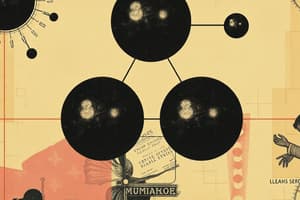Podcast
Questions and Answers
What is the driving force behind hydrophobic interactions?
What is the driving force behind hydrophobic interactions?
- Increasing the enthalpy of water
- Minimizing the favorable entropy of water (correct)
- Maximizing the unfavorable entropy of water
- Increasing the randomness of water
In the context of biochemical systems, what does a negative ΔG indicate?
In the context of biochemical systems, what does a negative ΔG indicate?
- Equilibrium in the reaction
- An increase in entropy
- Unfavorable and non-spontaneous reaction
- Favorable and spontaneous reaction (correct)
What does the term 'ΔS' represent in the thermodynamic equation ΔG = ΔH – TΔS?
What does the term 'ΔS' represent in the thermodynamic equation ΔG = ΔH – TΔS?
- Change in entropy or disorder (correct)
- Change in heat due to bond making and breaking
- Number of microstates
- Temperature in Kelvin
What type of interaction is characterized by attractive interactions between two fixed charge centers of opposite sign or repulsion between charges of the same sign?
What type of interaction is characterized by attractive interactions between two fixed charge centers of opposite sign or repulsion between charges of the same sign?
Which of the following contributes to the specificity in binding between biomolecules?
Which of the following contributes to the specificity in binding between biomolecules?
What determines the energy of an ionic interaction between two fixed charge centers?
What determines the energy of an ionic interaction between two fixed charge centers?
In biological systems, hydrogen bonds typically occur with which types of atoms?
In biological systems, hydrogen bonds typically occur with which types of atoms?
What type of bond is a covalent bond?
What type of bond is a covalent bond?
How many hydrogen bonds does a water molecule typically form?
How many hydrogen bonds does a water molecule typically form?
What leads to the hydrophobic effect?
What leads to the hydrophobic effect?
Which type of bond has the highest bond energy?
Which type of bond has the highest bond energy?
What is the typical bond length for F or S bonds?
What is the typical bond length for F or S bonds?
What is the typical bond energy required to break a hydrogen bond?
What is the typical bond energy required to break a hydrogen bond?
What is the main cause of the hydrophobic effect in an aqueous medium?
What is the main cause of the hydrophobic effect in an aqueous medium?
What is the range of bond energy for van der Waals interactions?
What is the range of bond energy for van der Waals interactions?
Flashcards are hidden until you start studying




